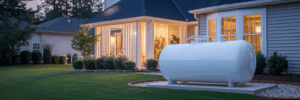
Propane’s Role in a Cleaner Energy Future
Since the U.S. Clean Air Act of 1990, propane has been designated as a clean fuel, a fact that anchors its role in modern energy conversations. Unlike gasoline or heating oil, it produces significantly fewer greenhouse gas emissions. This isn’t just a technicality; it has practical implications for both homes and businesses. Because propane burns so efficiently, less fuel is needed to power everything from a central furnace to a commercial kitchen cooktop. This inherent efficiency is the starting point for sustainable propane usage.
While propane already offers a cleaner alternative, its environmental benefits can be amplified through conscious management. The choices we make about our appliances, fuel supply, and daily habits directly influence how much energy we consume. By adopting smarter practices, we can build upon propane’s strong foundation to further reduce our footprint and costs. For more information on our commitment to clean energy, you can learn about our company’s history.
Optimizing Your Propane Appliances for Peak Efficiency
The journey toward greater efficiency often begins with the hardware that powers your home or business. Your furnace, water heater, and other propane appliances are the engines of your energy consumption, and their condition directly impacts your fuel usage and emissions. Making sure they run at their best is a foundational step.
The Importance of Regular Professional Maintenance
We can all relate to the “if it ain’t broke, don’t fix it” mindset. However, waiting for an appliance to fail is a costly approach. An annual tune-up by a qualified technician is one of the most effective ways to ensure your system is performing optimally. During a service visit, a professional will clean critical components and check for leaks, ensuring the fuel combusts completely. This process prevents wasted fuel and minimizes emissions, keeping your system running safely and efficiently.
Upgrading to High-Efficiency Models
If your propane furnace or water heater is more than a decade old, it might be operating far below modern efficiency standards. While the upfront cost of a new unit is a consideration, upgrading to an ENERGY STAR-rated appliance can reduce your propane use by 10% to 20%. This translates into significant long-term savings that often justify the initial investment. You can explore various types of modern propane equipment to see what might fit your needs.
Ensuring Proper Ventilation and System Integrity
An often-overlooked aspect of efficient propane heating is proper ventilation. A clean and unobstructed vent system allows your appliances to “breathe” correctly, supporting a clean burn and preventing the buildup of harmful byproducts. Beyond the appliance itself, check your home’s ductwork. Leaky ducts can lose a surprising amount of heated air before it ever reaches your rooms, forcing your furnace to work harder than necessary. Sealing these air leaks is a simple fix with a noticeable impact.
Smart Propane Tank and Supply Management
Beyond the appliances inside your building, how you manage your fuel supply plays a critical role in efficiency and safety. Thoughtful tank management not only prevents inconvenient run-outs but also contributes to a more streamlined and sustainable delivery process. It’s about working smarter, not harder, to maintain your energy supply.
Understanding the 80% Fill Rule for Safety and Efficiency
Have you ever wondered why your propane tank is never filled to 100%? This is a deliberate and crucial safety measure known as the 80% fill rule. Propane is stored as a liquid and needs room to expand as temperatures rise. That extra 20% of space in the tank provides a necessary buffer, preventing dangerous pressure buildup. Understanding this rule helps clarify delivery receipts and reinforces the safety protocols that protect your property.
Best Practices for Scheduling Refills
One of the most common anxieties for propane users is the fear of running out of fuel, especially during a cold snap. Running empty can cause pilot lights to go out, requiring a mandatory and sometimes costly system inspection before a refill. A simple rule of thumb is to schedule a delivery when your tank gauge reads between 25% and 30%. This provides ample time for a delivery without risking an interruption. These simple propane tank maintenance tips ensure continuous service. Some suppliers also offer automated tank monitoring systems that transmit fuel level data, helping optimize delivery routes and reduce vehicle emissions. For businesses, effective propane warehouse operations tank monitoring is key to maintaining productivity.
Pairing Propane with Renewable Energy Systems
The future of energy is not about choosing one source over another but about creating intelligent, hybrid systems. Propane is uniquely positioned to complement renewable energy sources like solar and wind, providing reliability when nature doesn’t cooperate. This forward-thinking approach ensures energy security while embracing cleaner technologies.
Propane as a Reliable Backup for Solar and Wind
Solar panels and wind turbines are excellent sources of clean energy, but their output is intermittent. What happens on a cloudy, windless day or during a power outage? A propane-powered generator acts as the perfect partner, kicking in automatically to provide seamless, uninterrupted power. Unlike battery storage, which has limited capacity, a propane generator can run for days, ensuring your home or business remains fully operational. This makes it a dependable solution for energy resilience.
Creating a Hybrid Heating System
Another smart strategy is a dual-fuel or hybrid heating system, which combines an electric heat pump with a high-efficiency propane furnace. The system intelligently switches between the two, using the electric heat pump during milder weather and activating the powerful propane furnace when temperatures drop significantly. This optimizes for both cost and comfort, giving you the best of both worlds. Looking ahead, the development of renewable propane for home use, produced from sources like biomass and vegetable oils, offers a “drop-in” replacement for conventional propane, making the transition to an even greener future seamless.
| Factor | Solar with Propane Backup | Solar with Battery Storage |
|---|---|---|
| Upfront Cost | Moderate | High |
| Reliability in Extreme Cold | High (Propane is unaffected) | Moderate (Battery performance can degrade) |
| Runtime During Outage | Very Long (Depends on propane tank size) | Limited (Depends on battery capacity) |
| Maintenance Needs | Generator and propane system servicing | Battery system monitoring and eventual replacement |
This table compares two common approaches to energy resilience. The data highlights the trade-offs between upfront investment and long-term reliability, particularly during extended power outages or severe weather conditions.
Everyday Habits to Reduce Propane Consumption
While equipment upgrades and maintenance are important, some of the most effective ways to conserve energy are tied to our daily routines. Small, consistent changes in behavior can add up to significant savings on your propane bill without requiring any major investment. The key is to be mindful of where your energy is going.
Start with your thermostat. Simply lowering the temperature by a few degrees overnight or when you’re away from home can make a real difference. A programmable or smart thermostat automates this process, ensuring you’re not heating an empty house. Another major area for savings is your hot water heater, which is often one of the largest propane consumers in a home. Thinking about how to reduce propane consumption here can yield great results.
Consider these simple adjustments:
- Wash clothes in cold water whenever possible. Modern detergents are highly effective in cold water, and this single change saves the energy needed to heat dozens of gallons of water per load.
- Take shorter showers. Cutting just a few minutes off your daily shower can dramatically reduce hot water demand over the course of a year.
- Promptly fix any leaky faucets. That slow drip might seem harmless, but it can waste a surprising amount of hot water and the propane used to heat it.
Finally, take a walk around your home and check for drafts around windows and doors. Sealing these gaps with inexpensive weatherstripping or caulk prevents heated air from escaping. In the winter, using heavy curtains can also provide an extra layer of insulation, keeping the warmth inside where it belongs.
Your Path to Efficient and Responsible Propane Use
Achieving sustainable energy use is not about a single grand gesture but a series of smart, manageable choices. By focusing on diligent appliance maintenance, intelligent tank management, and mindful daily habits, you can significantly reduce your propane consumption. Integrating propane with renewable energy sources further prepares you for a resilient and efficient energy future.
These practices deliver a powerful dual benefit: they lower your environmental impact while also reducing your energy bills. This makes sustainability an economically sound decision for any home or business owner. Ultimately, using propane responsibly empowers you to take control of your energy consumption, ensuring comfort and reliability without compromise. For more tips and insights on efficient energy use, visit our blog.
About Jennifer Whitaker
Propane industry expert and content contributor for MyPropane.com.
View all posts by Jennifer Whitaker →Related Articles

Five Propane Tank Mistakes That Risk Your Home's Safety
Oct 29, 2025 • 8 min read
Discover simple, effective ways to maintain your propane system and prevent hazardous situations with our straightforward advice.

Five Common Propane Tank Maintenance Mistakes To Avoid
Oct 10, 2025 • 7 min read
This guide details five frequent maintenance errors and provides simple steps to keep your propane system safe.

